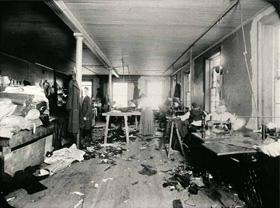Writing a High School Paper On the Triangle Fire
Before You Start
A research paper is based on primary sources, that is, on original documents. If you have never written a research paper before, you need to understand the difference between primary sources and secondary sources.
A primary source is material that is contemporary to the events being examined. Primary sources can be letters, contemporary newspaper accounts, or photographs. They can also be oral histories, memoirs, or autobiographies, later recollections of the time by someone who was there.
Secondary sources are books or articles written about an event or aspects of a past event, using primary sources. Secondary sources interpret original documents and are often historical narratives, that give you background information about the topic you want to research.
Before starting a research project on the Triangle Fire, read an account of the event, such as Leon Stein's book The Triangle Fire and relevant documents from his Out of the Sweatshop. The latter book is out of print but the local library might have it or be able to obtain it through interlibrary loan. Parts of both books are available by following the links on this site. Stein's book on the fire is a secondary source, one that he wrote about the fire using primary sources. His book, Out of the Sweatshop, is a collection of primary sources.
Most importantly, though, rely on your teacher for guidance on the mechanics of writing a paper (Selecting and narrowing the topic; Writing the thesis statement; Doing the research; Taking notes; Citing sources; Writing the Introduction; Writing the detailed Outline; Writing the Rough Draft ; Presenting the research to the class as an Oral presentation; Writing the Final Draft with Bibliography). Make sure you get all this information BEFORE you start your research!
Selecting Your Sources
Using the World Wide Web to do historical research is insufficient. In the case of the Triangle Fire, we have selected some primary and secondary sources for you, but more are available in archives. Never assume that what you see on the Web is all you can get! Often valuable documents are still on paper, safely preserved in archives or on microfilm. Always ask for help from a librarian or archivist! Also, be aware of the limitations of research on the Web! Not everything you see is accurate. Make sure that the person or institution that places information on the Web is reputable and established. When in doubt, ask your teacher. Check all leads for other possible resources. Most important, seek the guidance of teachers and use the resources of your public library. Books can often be obtained through interlibrary loan and a reference librarian can show you other sources and methods of searching for information. Articles about the fire are easy to locate both on the Web and in print. Check our online Selected Bibliography for references.
Citing Your Sources
If you use this Web site as your main source for your paper, you need to credit it! Plagiarism is the act of stealing the ideas and/or words of another writer and passing them off as one's own. When a researcher uses someone else's ideas, he/she is required to credit the source. The student should always read, take notes, and then write the paper in his/her own words. Any source used in research must be credited in the final document. Citations to World Wide Web material should note both the URL and the original location of the document. Web pages come and go, so it is necessary to cite the original location also. Most recent editions of citation guides provide information on how to cite Web pages.
See the useful citation examples provided by the Robert E. Kennedy Library at CalPoly: http://lib.calpoly.edu/research-and-help/citations/
For example, if you wish to cite excerpts from the chapter "Fire" taken from Leon Stein's book as they appear on the web site, according to the Chicago Manual of Style you should use the following format:
"Fire," excerpts from Leon Stein's The Triangle Fire, accessed February 13, 2014, http://trianglefire.ilr.cornell.edu/primary/testimonials/tf_fire.html?sto_sec=fire
If you wish to simply cite our web site in general and not a specific section of it, please remember that the author is the Kheel Center:
Kheel Center, Cornell University. The 1911 Triangle Factory Fire, accessed February 13, 2014, http://www.ilr.cornell.edu/index.html
Please see the video at the link below as an example of what you can do with the material featured in this site. High school students Jasmine Swann and Sydney Palmer created the video for a school project: https://www.youtube.com/watch?v=fC0GaSH-qvw
Do not hesitate to contact us for more information! kheel_center@cornell.edu

